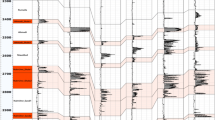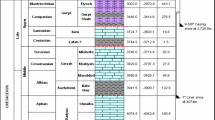Abstract
Well drilling is considered the main activity to access oil reservoirs for oil production. Shear failure during drilling operation occurs when drilling mud pressure is reduced from a certain value known as critical or rupture pressure. Therefore, a proper drilling mud pressure is required to avoid the occurrence of any shear failure even to the smallest extent. This study aimed at achieving a criterion for estimating the minimum drilling mud pressure to prevent shear failure in oil wells. To this end, data on oil wells were first collected. Then oil wells were modeled at different drilling mud pressures with the help of finite difference numerical program, FLAC2D. The normalized yielded zone area (NYZA) in the elasto-plastic method was used for stability analysis and estimation of the minimum drilling mud pressure to prevent shear failure. After plotting the NYZA chart for each well, the minimum drilling mud pressure was calculated at NYZA = 1 and a correlation was then extracted by multivariate linear regression with the help of SPSS. This linear correlation is able to estimate the minimum drilling mud pressure to prevent shear failure taking into account the minimum and maximum horizontal stresses, pore pressure, internal friction angle and cohesion.





Similar content being viewed by others
References
Aadnoy BS, Kaarstad E (2010) History model for sand production during depletion. In: SPE EUROPEC/EAGE annual conference and exhibition. Society of Petroleum Engineers
Al-Ajmi AM, Zimmerman RW (2005) Relation between the Mogi and the Coulomb failure criteria. Int J Rock Mech Min Sci 42(3):431–439
Al-Ajmi AM, Zimmerman RW (2006) Stability analysis of vertical boreholes using the Mogi–Coulomb failure criterion. Int J Rock Mech Min Sci 43(8):1200–1211
Ali AHA, Brown T, Delgado R, Lee D, Plumb D, Smirnov N, Marsden R, Prado-Velarde E, Ramsey L, Spooner D, Stone T (2003) Watching rocks change—mechanical earth modeling. Oilfield Rev. 15(1):22–39
Ameen MS, Smart BG, Somerville JM, Hammilton S, Naji NA (2009) Predicting rock mechanical properties of carbonates from wireline logs (A case study: Arab-D reservoir, Ghawar field, Saudi Arabia). Mar Pet Geol 26(4):430–444
Esmailian M, Rabiee MR (2015) Comprehensive SPSS 22 help. Dibagaran Tehran Art & Cultural Institute, Tehran
Ewy RT (1999) Wellbore-stability predictions by use of a modified Lade criterion. SPE Drill Complet 14(02):85–91
Farzai A, Khatibi SA (2016) Determination of optimal drilling mud pressure in Kangan and Upper Dalan formations based on core data. In: 2nd national conference on oil geomechanics
Fjaer E, Holt RM, Horsrud P, Raaen AM, Risnes R (2008) Petroleum Related Rock Mechanics, 2nd edn. Elsevier, Amesterdam
Hawkes CD, McLellan PJ (1996) Modeling of yielded zone enlargement around a wellbore. In: 2nd North American rock mechanics symposium. American Rock Mechanics Association
Kristiansen TG, Barkved O, Pattillo PD (2000) Use of passive seismic monitoring in well and casing design in the compacting and subsiding Valhall field, North Sea. In: SPE European petroleum conference. Society of Petroleum Engineers
Li Q, Tang Z (2016) Optimization of wellbore trajectory using the initial collapse volume. J Nat Gas Sci Eng 29:80–88
Maleki S, Gholami R, Rasouli V, Moradzadeh A, Riabi RG, Sadaghzadeh F (2014) Comparison of different failure criteria in prediction of safe mud weigh window in drilling practice. Earth Sci Rev 136:36–58
Mirzaghorbanali A, Afshar M (2011) A mud weight window investigation based on the Mogi–Coulomb failure criterion and elasto-plastic constitutive model. Pet Sci Technol 29(2):121–131
Moos D, Barton CA, Willson S (2007) Impact of rock properties on the relationship between wellbore breakout width and depth. In: 1st Canada-US rock mechanics symposium. American Rock Mechanics Association
Najibi AR, Ghafoori M, Lashkaripour GR, Asef MR (2015) Empirical relations between strength and static and dynamic elastic properties of Asmari and Sarvak limestones, two main oil reservoirs in Iran. J Pet Sci Eng 126:78–82
Sasaninia N, Rezaei Mirghaed F, Shabkoohi Kahkesh A (2015) Determination of optimal drilling mud pressure range using FLAC in one of the southwestern oil fields of Iran. In: International conference on research in science and technology
Shahbazi S (2015) Numerical modeling of oil well behavior in shale formations. MSc thesis, Imam Khomeini International University
Wiprut DJ, Zoback MD (1998) High horizontal stress in the Visund field, Norwegian North Sea: consequences for borehole stability and sand production. In: SPE/ISRM rock mechanics in petroleum engineering. Society of Petroleum Engineers
Xu G (2007) Wellbore stability in geomechanics. Doctoral dissertation, University of Nottingham
Yuan JL, Deng JG, Tan Q, Yu BH, Jin XC (2013) Borehole stability analysis of horizontal drilling in shale gas reservoirs. Rock Mech Rock Eng 46(5):1157–1164
Zhang L, Radha KC (2010) Stability analysis of vertical boreholes using a three-dimensional Hoek–Brown strength criterion. In: GeoFlorida 2010: advances in analysis, modeling and design, pp 283–292
Zhang W, Gao J, Lan K, Liu X, Feng G, Ma Q (2015) Analysis of borehole collapse and fracture initiation positions and drilling trajectory optimization. J Pet Sci Eng 129:29–39
Zoback MD (2010) Reservoir geomechanics. Cambridge University Press, Cambridge
Acknowledgements
The authors wish to thank the Drilling and Petrophysical Department of Iranian South Oil Company, in particularly Mr. Babadi and Kordavani and Mrs. Alboghobeish for their help during various stages of this study.
Author information
Authors and Affiliations
Corresponding author
Additional information
Publisher's Note
Springer Nature remains neutral with regard to jurisdictional claims in published maps and institutional affiliations.
Rights and permissions
About this article
Cite this article
Behnam, N., Hosseini, M. & Shahbazi, S. A Criterion for Estimating the Minimum Drilling Mud Pressure to Prevent Shear Failure in Oil Wells. Geotech Geol Eng 38, 227–236 (2020). https://doi.org/10.1007/s10706-019-01012-x
Received:
Accepted:
Published:
Issue Date:
DOI: https://doi.org/10.1007/s10706-019-01012-x




